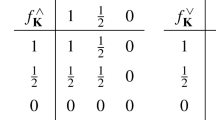Abstract
Many analyses of notion of metainferences in the non-transitive logic ST have tackled the question of whether ST can be identified with classical logic. In this paper, we argue that the primary analyses are overly restrictive of the notion of metainference. We offer a more elegant and tractable semantics for the strict-tolerant hierarchy based on the three-valued function for the LP material conditional. This semantics can be shown to easily handle the introduction of mixed inferences, i.e., inferences involving objects belonging to more than one (meta)inferential level and solves several other limitations of the ST hierarchies introduced by Barrio, Pailos, and Szmuc.
Article PDF
Similar content being viewed by others
Avoid common mistakes on your manuscript.
References
Avron, A. (1988). The semantics and proof theory of linear logic. Theoretical Computer Science, 57(2-3), 161–184.
Barrio, E., Rosenblatt, L., & Tajer, D. (2015). The logics of strict-tolerant logic. Journal of Philosophical Logic, 44(5), 551–571.
Barrio, E., Pailos, F., & Szmuc, D. (2020). A hierarchy of classical and paraconsistent logics. Journal of Philosophical Logic, 49(1), 93–120.
Brouwer, L.E.J (1928). Mathematik, Wissenschaft und Sprache. Monatshefte fur̈ Mathematik und Physik, 36, 153–164.
Brouwer, L.E.J. (1996). Mathematics, science, and language. In W. Ewald (Ed.) From Kant to Hilbert, (Vol. II pp. 1170–1185). Oxford: Oxford University Press.
Cobreros, P., Egré, P., Ripley, D., & van Rooij, R. (2012). Tolerant, classical, strict. Journal of Philosophical Logic, 41(2), 347–385.
Cobreros, P., Egré, P., Ripley, D., & van Rooij, R. (2014). Reaching transparent truth. Mind, 122(488), 841–866.
Dicher, B., & Paoli, F. (2018). ST, LP, and tolerant metainferences. In T. M. Ferguson C. Baskent (Eds.) Graham Priest on Dialetheism and Paraconsistency (pp. 383–407). Cham: Springer.
Dummett, M. (1978). Truth and other enigmas. London: Gerald Duckworth & Company.
Fjellstad, A. (2016). Naive modus ponens and failure of transitivity. Journal of Philosophical Logic, 45(1), 65–72.
French, R. (2016). Structural reflexivity and the paradoxes of self-reference. Ergo, 3(5), 113–131.
Heyting, A. (1976). Intuitionism: An Introduction, 3rd edn. Amsterdam: North-Holland Publishing.
Mares, E., & Paoli, F. (2014). Logical consequence and the paradoxes. Journal of Philosophical Logic, 43(2-3), 439–469.
Priest, G. (1979). The logic of paradox. Journal of Philosophical Logic, 8(1), 219–241.
Restall, G. (2005). Multiple conclusions. In P. Hajek, L. Valdes-Villanueva, & D. Westerståhl (Eds.) Logic, Methodology, and Philosophy of Science: Proceedings of the Twelfth International Congress (pp. 189–205). London: Kings College.
Ripley, D. (2012). Conservatively extending classical logic with transparent truth. Review of Symbolic Logic, 5(2), 354–378.
Ripley, D. (2013). Paradoxes and failures of cut. Australasian Journal of Philosophy, 91(1), 139–164.
Routley, R. (1982). Relevant Logics and their Rivals Vol. 1. CA: Ridgeview Publishing, Atascadero.
Zardini, E. (2013). Naive modus ponens. Journal of Philosophical Logic, 42(4), 575–593.
Author information
Authors and Affiliations
Corresponding author
Additional information
Publisher’s Note
Springer Nature remains neutral with regard to jurisdictional claims in published maps and institutional affiliations.
The results in this paper have largely been presented in talks given to the VII Workshop on Philosophical Logic in 2018, the ASL Logic Colloquium in 2019, and the CUNY/NYU Workshop on Metainferences in 2019. The authors acknowledge the many helpful comments that were received by attendees of these talks.
Rights and permissions
Open Access This article is licensed under a Creative Commons Attribution 4.0 International License, which permits use, sharing, adaptation, distribution and reproduction in any medium or format, as long as you give appropriate credit to the original author(s) and the source, provide a link to the Creative Commons licence, and indicate if changes were made. The images or other third party material in this article are included in the article's Creative Commons licence, unless indicated otherwise in a credit line to the material. If material is not included in the article's Creative Commons licence and your intended use is not permitted by statutory regulation or exceeds the permitted use, you will need to obtain permission directly from the copyright holder. To view a copy of this licence, visit http://creativecommons.org/licenses/by/4.0/.
About this article
Cite this article
Ferguson, T.M., Ramírez-Cámara, E. Deep ST. J Philos Logic 51, 1261–1293 (2022). https://doi.org/10.1007/s10992-021-09630-8
Received:
Accepted:
Published:
Issue Date:
DOI: https://doi.org/10.1007/s10992-021-09630-8




